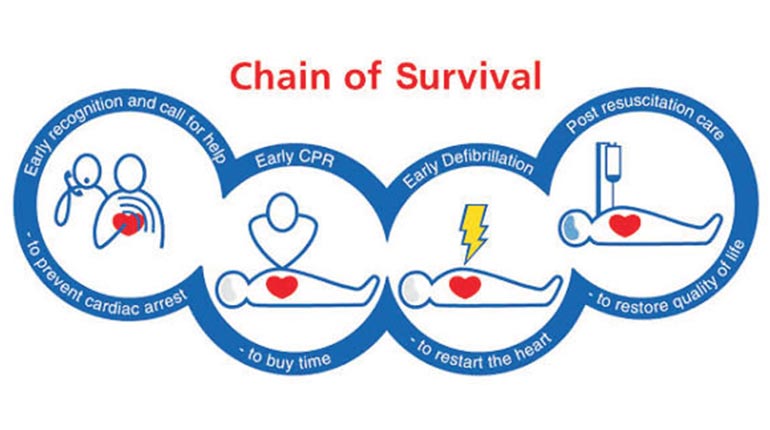ABOUT THE COURSES
ACLS is designed for healthcare professionals who either direct or participate in the management of cardiopulmonary arrest and other cardiovascular emergencies. This includes personnel in emergency response, emergency medicine, intensive care and critical care units. ACLS emphasizes the importance of basic life support CPR to patient survival; the integration of effective basic life support with advanced cardiovascular life support interventions; and the importance of effective team interaction and communication during resuscitation.
What You Will Learn
-
Systems of Care
- Cardiopulmonary Resuscitation
- Acute Coronary Syndrome
- Acute Stroke
- Post Cardiac Arrest Care
-
Effective Hight Performance Team Dynamics - The Systematic Approach
- BLS Assessment
- The Primary Assessment
- The Secondary
- Diagnosing & Treating Underlying Causes
-
ACLS Cases
- Respiratory Arrest Cases
- Acute Corornary Syndromes Cases
- Acute Stroke Case
- Cardic Arrest - VF/ Pulseless VT Cases
- Cardic Arrest - Pulseless Electrical Activity Case
- Cardic Arrest - Asystole Case
- Bradycardia Case
- Tachycardia Case - Stable & Unstable
- Immediate Post Cardic Arrest Care Case
-
COURSE SYLLABUS
-
BASIC LIFE SUPPORT
1. BLS ASESSMENT
2. PRIMARY ASSESSMENT
3. RESPIRATORY DISTRESS AND FAILURE
4. MANAGEMENT OF RESPIRATORY ARREST
5. GIVING SUPPLEMENT OXYGEN
6. OPENING AIRWAY
7. PROVIDING BASIC VENTILLATION
8. BASIC AIRWAY AGDJUNCTS: OPA AND NPA
9. SUCTIONING
10. PROVINDING VENTILATION WITH AN ADVANCED AIRWAY -
ACUTE CORONARY SYNDROMES
1. INTRODUCTION , RHYTHMS FOR ACS, DRUGS OF ACS
2. GOALS OF ACS PATIENTS
3. MANAGING ACS
4. INDENTIFICATION OF CHEST DISCOMFORT SUGGESTIVE OF ISCHEMIA
5. EMS ASSESSMENT ,CARE AND HOSPITAL PREPARATION
6. IMMEDIATE ED ASSESSMENT AND TREATMENT
7. CLASSIFY PATIENTS ACCORDING TO ST – SEGMENT DEVIATION
8. STEMI -
CARDIAC ARREST- VF/ PULSELESS VT
1. INTRODUCTION
2. MANAGING VF/PULSELESS VT
3. APPLICATION OF THE CARDIAC ARREST ALGORITHM- VF/ PULSELESS VT
4. ROUTES OF ACCESS FOR GRUGS
5. VASOPRESSORS
6. ANTIARRHYTMIC AGENTS
7. EXTRACORPOREAL CPR- FORCARDIAC ARREST RHYTHM
8. ULTRASOUND FOR CARDIAC ARREST RHYTHM -
CARDIAC ARREST- PULSELESS ELECTRICAL ARREST
1. INTRODUCTION
2. DESCRIPTION OF PEA
3. MANAGING PEA -
CARDIAC ARREST- ASYSTOLE
1. INTRODUCTION
2. APPROACH TO ASYSTOLE
3. MANAGING ASYSTOLE
4. APPLICATION OF THE CARDIAC ARREST ALGORITHM- ASYSTOLE
5. TERMINATING RESUSCITATION EFFORTS -
CARDIAC ARRHTHMIAS
1. BRADYCARDIA
a. INTRODUCTION
b. DESCRIPTION OF BRADYCARDIA
c. MANAGING BRADYCARDIA- BRADYCARDIA ALGORITHM
d. APPLICATION OF BRADYCARDIA ALGORITHM
e. TRANSCUTANEOUS PACING
2. TACHYCARDIA- STABLE AND UNSTABLE
a. INTRODUCTION
b. APPROACH TO UNSTABLE TACHYCARDIA
c. MANAGING UNSTABLE TACHYCARDIA- TACHYCARDIA ALGORITHM
d. APPLICATION OF TACHYCARDIA ALOGORITHM TO THE UNSTABLE PATIENT
e. CARDIOVERSION
f. SYNCHRONISED CARDIOVERSION TECHNIQUE
g. APPROACH TO STABLE TACHYCARDIA
h. MANAGING STABLE TACHYCARDIA- ALGORITHM
i. APPLICATION OF TACHYCARDIA ALOGORITHM TO STABLE PATIENT -
IMMEDIATE POST CARDIAC ARREST CARE
1. INTRODUCTION
2. MANAGING POST-CARDIAC ARREST CARE
3. APPLICATION OF THE IMMEDIATE POST-CARDIAC ARREST CARE ALGORITHM
-
BASIC LIFE SUPPORT
Certification
American Heart Association BLS/ACLS/PALS for Healthcare Providers Course Completion Card, which is valid for two years. In the classroom, students participate in simulated clinical scenarios and learning stations. Students work with an AHA BLS Instructor to complete BLS skills practice and skills testing. Students also complete a written exam.


